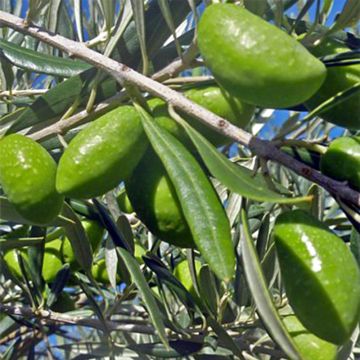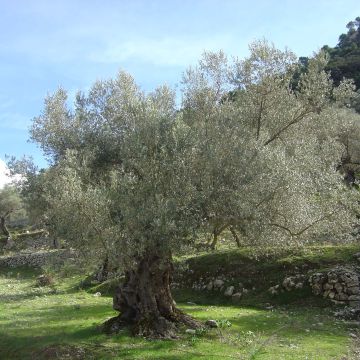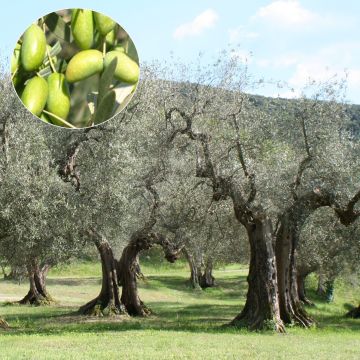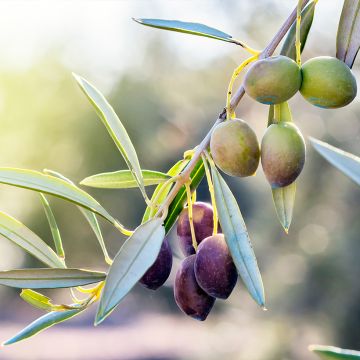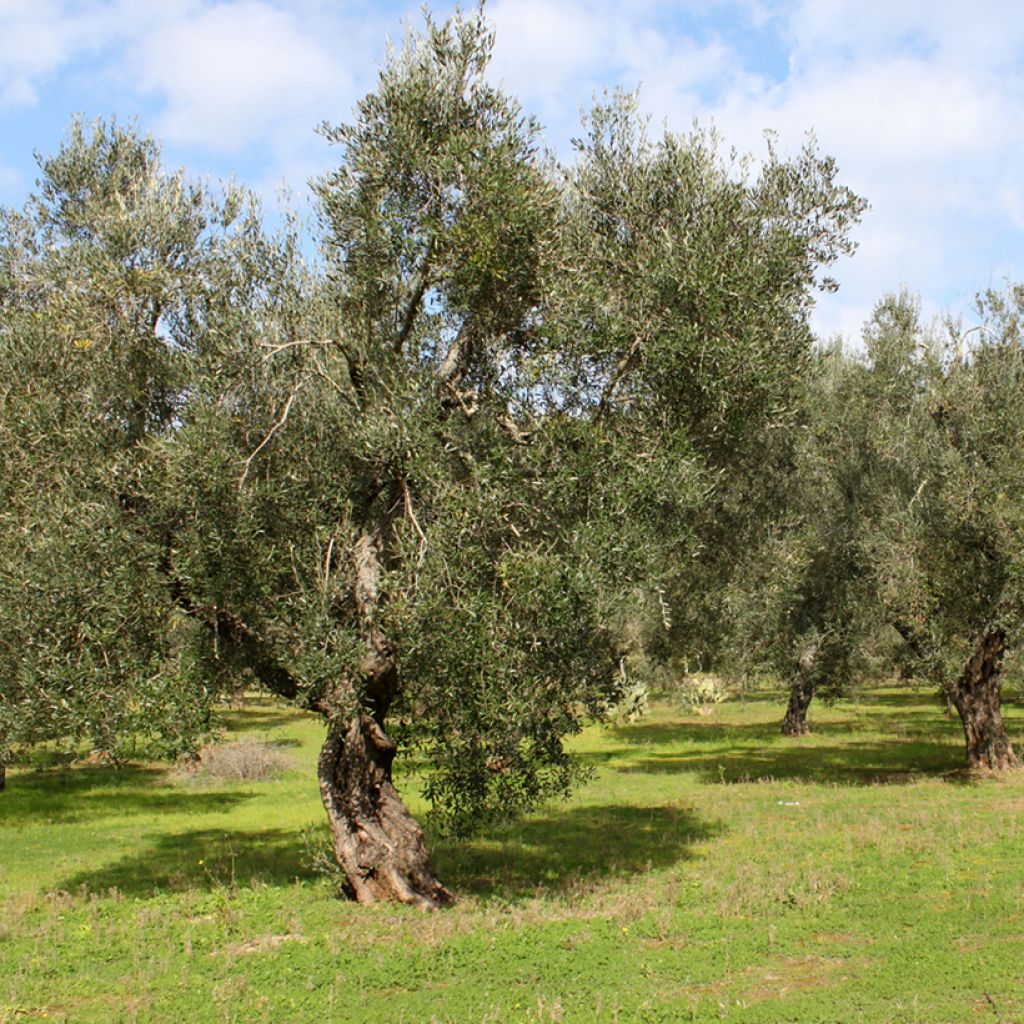

Olea europaea Frantoio - Olive Tree
Olea europaea Frantoio - Olive Tree
Olea europaea Frantoio
European Olive, Olive Tree
This item cannot be shipped to the selected country
Delivery charge from €5.90
Delivery to Corse prohibited
More information
Schedule delivery date,
and select date in basket
This plant carries a 6 months recovery warranty
More information
We guarantee the quality of our plants for a full growing cycle, and will replace at our expense any plant that fails to recover under normal climatic and planting conditions.
From €5.90 for pickup delivery and €6.90 for home delivery
Express home delivery from €8.90.
Delivery to Corse prohibited: UE law prohibits the import of this plant from mainland France to Corse as part of the fight against Xylella fastidiosa. Please accept our sincere apologies.
More information
Description
The 'Frantoio Olive Tree' is a great Italian classic. This variety originating from Tuscany has many qualities and is currently grown in many olive-growing regions. The tree has vigorous growth and quickly bears fruit, even at a young age. It is self-fertile and has almost no alternate bearing. Its productivity will be further improved by cross-pollination. Its ovoid olives are harvested quite late in the season when they begin to turn purplish. They produce a renowned virgin oil known for its fine flavour and good storage.
Do not buy an old subject that has been uprooted without care from its native soil: it will take 5 or 10 years to recover, or perish! Instead, plant a young olive tree that is "happy in its pot", water it regularly for the first two or three summers, and you will be amazed at how quickly it develops!
The presence of the Olea europea, simply called Olive, all around the Mediterranean, dates back to ancient times. Both an ornamental tree and a food tree, it is inseparable from the Mediterranean landscape, just like the fig tree, the holm oak, the Provence cypress 'Pyramidalis', the pomegranate, and the grapevine. This emblematic tree has given its name to the botanical family Oleaceae.
Olea europeae 'Frantoio' is also known by the names 'Bresa', 'Cailletier', 'Correggiolo', 'Crognolo', 'Infrantoio', 'Laurin', 'Pignatello', 'Radius', 'Raggiolo', 'Rajo', 'Solciaro', and Stringona. Due to its taste qualities, this variety is cultivated in many countries including Pakistan.
The 'Frantoio Olive Tree' has a distinctive silhouette due to its long, flexible branches that slightly droop, especially when laden with fruit. It eventually forms a spreading tree with a wide crown reaching about 4m in height and 3m in width, or even more. Its growth is fast for an olive tree. The tree develops a sturdy and knotty trunk as it ages. Its evergreen foliage is composed of more or less narrow, opposite, entire, elliptical leaves that are leathery and covered with scale-like hairs, measuring 3 to 7 cm in length. They cover branches dotted with peltate scales. Their colour is a mix of green and grey, with the undersides of the leaves being more silvery. The very brief, nectar-rich flowering takes place for one week between May and June, depending on the climate. The white or yellowish flowers are grouped in axillary panicles. The fruits, the olives, are oval, green, fleshy drupes with hard stones, partially turning purple when ripe. They have an extremely bitter taste and are not edible as they are: they must undergo processing or a very long ripening off the tree before being consumed as table olives. The oil extracted from their pulp, however, is immediately consumable. With excellent characteristics, it has complex aromas including tomato leaf, artichoke, almond, herbs, rocket, and dried fruits. In the mouth, it is a fine and creamy oil with bitter and spicy notes. This fruiting occurs on trees aged five to six years. The bark of this olive tree is grey and smooth when young and cracks with age, while the tree produces shoots at the base of the trunk.
The 'Frantoio Olive Tree' is very resistant to summer drought and appreciates well-drained, even rocky soils. However, it cannot tolerate temperatures below -9/-10°C (adult). Cultivation in open ground is reserved for the olive zone, as it is aptly named. However, enthusiasts of this small tree can adopt it in a large container anywhere else, protecting it from severe cold in winter. The 'Frantoio Olive Tree' is self-fertile. The presence of a nearby compatible tree is not obligatory for the pollination of its flowers, but it will be particularly productive in the presence of a 'Pendolino' or 'Leccino' olive tree. It should be noted that it is an excellent pollinator for other olive varieties.
A very old tree: the Olive Tree, named "The King of Kings" in Roquebrune-Cap-Martin, in the Alpes-Maritimes, has a trunk with a circumference of 20m, which encompasses the surrounding rocks; it is estimated to be 1000 to 2000 years old.
Report an error about the product description
Plant habit
Fruit
Flowering
Foliage
Safety measures
Botanical data
Olea
europaea
Frantoio
Oleaceae
European Olive, Olive Tree
Olea europaea Bresa, Cailletier, Correggiolo, Crognolo, Frantoio, Infrantoio, Laurin, Pignatello, Radius, Raggiolo, Rajo, Solciaro, Stringona.
Mediterranean
atteinterespiratoire
Cette plante peut entraîner des symptômes allergiques.
Evitez de la planter si vous ou vos proches souffrez de rhinite saisonnière ("rhume des foins").
Davantage d'informations sur https://plantes-risque.info
Other Olive trees
Planting and care
The 'Frantoio' Olive tree is best planted in spring, as young plants are particularly sensitive to cold, while well-established subjects that are a few years old can withstand short frosts of around -9 to -10°C. If you plant the olive tree in open ground, dig a basin around the tree. Do not install it in the middle of the lawn, as it would suffer from regular watering, which would cause asphyxiation and root rot. The olive tree is content with ordinary soil, even limestone and stony soil, but above all it needs to be permeable and well-drained. It tolerates summer drought perfectly, sometimes at the expense of the harvest. It also requires a sunny location sheltered from cold winds, especially outside the area where it is traditionally grown.
Respect a spacing of 2m between each tree.
For an olive tree grown in a pot, place a draining layer of soil, sand, and small stones at the bottom. Repot every 2 or 3 years.
Use a 2.50m high stake to ensure an upright habit for the tree as it grows. Adjust the height of the stake according to the size of your olive tree in the case of pot cultivation.
Diseases and pests: there are many, but rarely fatal
The Olive fly, mainly troublesome for fruit production. Thrips, black scale, often accompanied by sooty mould. Bark beetles, moths, spirals.
With one exception, a fungal disease called root rot that attacks the roots and then spreads throughout the branches, olive tree diseases are not lethal and can be easily treated or disappear on their own.
Planting period
Intended location
Care
This item has not been reviewed yet - be the first to leave a review about it.
Haven't found what you were looking for?
Hardiness is the lowest winter temperature a plant can endure without suffering serious damage or even dying. However, hardiness is affected by location (a sheltered area, such as a patio), protection (winter cover) and soil type (hardiness is improved by well-drained soil).

Photo Sharing Terms & Conditions
In order to encourage gardeners to interact and share their experiences, Promesse de fleurs offers various media enabling content to be uploaded onto its Site - in particular via the ‘Photo sharing’ module.
The User agrees to refrain from:
- Posting any content that is illegal, prejudicial, insulting, racist, inciteful to hatred, revisionist, contrary to public decency, that infringes on privacy or on the privacy rights of third parties, in particular the publicity rights of persons and goods, intellectual property rights, or the right to privacy.
- Submitting content on behalf of a third party;
- Impersonate the identity of a third party and/or publish any personal information about a third party;
In general, the User undertakes to refrain from any unethical behaviour.
All Content (in particular text, comments, files, images, photos, videos, creative works, etc.), which may be subject to property or intellectual property rights, image or other private rights, shall remain the property of the User, subject to the limited rights granted by the terms of the licence granted by Promesse de fleurs as stated below. Users are at liberty to publish or not to publish such Content on the Site, notably via the ‘Photo Sharing’ facility, and accept that this Content shall be made public and freely accessible, notably on the Internet.
Users further acknowledge, undertake to have ,and guarantee that they hold all necessary rights and permissions to publish such material on the Site, in particular with regard to the legislation in force pertaining to any privacy, property, intellectual property, image, or contractual rights, or rights of any other nature. By publishing such Content on the Site, Users acknowledge accepting full liability as publishers of the Content within the meaning of the law, and grant Promesse de fleurs, free of charge, an inclusive, worldwide licence for the said Content for the entire duration of its publication, including all reproduction, representation, up/downloading, displaying, performing, transmission, and storage rights.
Users also grant permission for their name to be linked to the Content and accept that this link may not always be made available.
By engaging in posting material, Users consent to their Content becoming automatically accessible on the Internet, in particular on other sites and/or blogs and/or web pages of the Promesse de fleurs site, including in particular social pages and the Promesse de fleurs catalogue.
Users may secure the removal of entrusted content free of charge by issuing a simple request via our contact form.
The flowering period indicated on our website applies to countries and regions located in USDA zone 8 (France, the United Kingdom, Ireland, the Netherlands, etc.)
It will vary according to where you live:
- In zones 9 to 10 (Italy, Spain, Greece, etc.), flowering will occur about 2 to 4 weeks earlier.
- In zones 6 to 7 (Germany, Poland, Slovenia, and lower mountainous regions), flowering will be delayed by 2 to 3 weeks.
- In zone 5 (Central Europe, Scandinavia), blooming will be delayed by 3 to 5 weeks.
In temperate climates, pruning of spring-flowering shrubs (forsythia, spireas, etc.) should be done just after flowering.
Pruning of summer-flowering shrubs (Indian Lilac, Perovskia, etc.) can be done in winter or spring.
In cold regions as well as with frost-sensitive plants, avoid pruning too early when severe frosts may still occur.
The planting period indicated on our website applies to countries and regions located in USDA zone 8 (France, United Kingdom, Ireland, Netherlands).
It will vary according to where you live:
- In Mediterranean zones (Marseille, Madrid, Milan, etc.), autumn and winter are the best planting periods.
- In continental zones (Strasbourg, Munich, Vienna, etc.), delay planting by 2 to 3 weeks in spring and bring it forward by 2 to 4 weeks in autumn.
- In mountainous regions (the Alps, Pyrenees, Carpathians, etc.), it is best to plant in late spring (May-June) or late summer (August-September).
The harvesting period indicated on our website applies to countries and regions in USDA zone 8 (France, England, Ireland, the Netherlands).
In colder areas (Scandinavia, Poland, Austria...) fruit and vegetable harvests are likely to be delayed by 3-4 weeks.
In warmer areas (Italy, Spain, Greece, etc.), harvesting will probably take place earlier, depending on weather conditions.
The sowing periods indicated on our website apply to countries and regions within USDA Zone 8 (France, UK, Ireland, Netherlands).
In colder areas (Scandinavia, Poland, Austria...), delay any outdoor sowing by 3-4 weeks, or sow under glass.
In warmer climes (Italy, Spain, Greece, etc.), bring outdoor sowing forward by a few weeks.

































